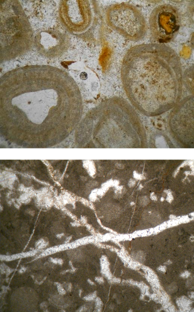© All rights reserved
Geological Services
Core Description &
Reservoir Sedimentology
High-resolution sedimentological core logging (at 1:50, 1:20 scale, or chosen by client) of new cores and reconsideration/ re-evaluation of old cores using ‘facies analysis’ approach. Separation and description of component facies and sequences, at different orders, from cored successions, followed by facies interpretation in terms of depositional processes, sedimentary environments and controlling factors. All descriptive facies are recorded in integrated core description logs (WellCAD format); data can be exported in various formats (tabular, charts, etc.) at request. Interpreted depositional facies can be summarized graphically in catalogues of ‘facies montages’.



Petrographic Services
Petrographic services provided include TS analysis (core samples and cuttings), point count (Petrog), Digital Image Analysis, SEM analysis for the characterization of clay minerals, microporosity system and carbonates (matrix vs. orthochems), EDX for chemical mapping and elemental analysis of targeted reservoir petro-types and rock-typing for petrographical/ petrophysical assessment of cuttings/core samples in order to create analogue data useful for exploration studies.



Regional Geology & Paleogeography
High-resolution sedimentological description of target stratigraphic sections, involving detailed logging of drilled sequences using all available rock-support (e.g. cores, cuttings, SWC), tied to wireline logs suite, followed by interpretation of depositional facies & sequences and related geobodies (i.e., architectural elements). In multi-well studies these are further correlated (at field or basinal scale), between interpreted key surfaces (of different orders), to visualize the spatial distribution of sedimentary bodies (reservoirs and seals) for successive time slices in paleogeography/ GDE maps. Petrographic data is also integrated to provide framework mineralogy and postdepositional (diagenetic) effects and their timing on reservoir quality (poro-perm features).
Data is recorded in integrated sedimentary logs (usually 1:2000, 1:1000, or 1:500, WellCAD-based). Correlation panels and GDE maps are provided in graphic format.

Training
Training courses in sedimentology, petrography/ reservoir quality, sedimentological core description, sedimentary facies analysis & reconstruction of depositional environments from core, cuttings & wireline logs, addressed to geologists, geoscientists, geological engineers and academics. Training sessions can be provided at client’s location or online, at competitive daily rates. Field training (in ‘field trip’ format) can also be provided. For more details see ‘Training’ section.


Additional Services
Outcrop studies (sedimentology, structural geology). Review of legacy geological data/ analyses provided by clients. Petrographic (thin section analysis) for mineral industry (sands, limestones, shales, gypsums, tuffs). Textural/grain size analysis. Provenance studies/ source areas reconstruction. Diagenetic logs/ studies. Digital image analysis of TS/ SEM photomicrographs. Digital image analysis of CT scans (plugs, cores). Report compilation.
For any enquiries on geological services please contact us using the ‘Contact’ form.



Hemipelagitic fines (left) grading to thinly-bedded,
distal lobe turbidites (right)
Turbidite lobe sequence (channelized at top)
Turbidite channel (base at left, marked)


Triassic dolomites (Southern Alps)
Jurassic stromatolites (Southern Apennines)



Large nodular (i.e., chicken-wire) anhydrite
En-masse resedimented evaporites
(gypsum parabreccia)
Rhythmically-bedded evaporites (mainly gypsum)


Wavy- to ripple-bedded structures in vitro-crystalloclastic tuff
Laminated to convoluted (left) and dewatering/
dish-and-pillar structures (right) in tuffs
